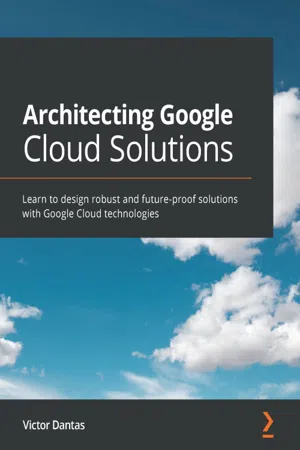
Architecting Google Cloud Solutions
Victor Dantas
- 472 pages
- English
- ePUB (mobile friendly)
- Available on iOS & Android
Architecting Google Cloud Solutions
Victor Dantas
About This Book
Achieve your business goals and build highly available, scalable, and secure cloud infrastructure by designing robust and cost-effective solutions as a Google Cloud Architect.Key Features• Gain hands-on experience in designing and managing high-performance cloud solutions• Leverage Google Cloud Platform to optimize technical and business processes using cutting-edge technologies and services• Use Google Cloud Big Data, AI, and ML services to design scalable and intelligent data solutionsBook DescriptionGoogle has been one of the top players in the public cloud domain thanks to its agility and performance capabilities. This book will help you design, develop, and manage robust, secure, and dynamic solutions to successfully meet your business needs. You'll learn how to plan and design network, compute, storage, and big data systems that incorporate security and compliance from the ground up. The chapters will cover simple to complex use cases for devising solutions to business problems, before focusing on how to leverage Google Cloud's Platform-as-a-Service (PaaS) and Software-as-a-Service (SaaS) capabilities for designing modern no-operations platforms. Throughout this book, you'll discover how to design for scalability, resiliency, and high availability. Later, you'll find out how to use Google Cloud to design modern applications using microservices architecture, automation, and Infrastructure-as-Code (IaC) practices. The concluding chapters then demonstrate how to apply machine learning and artificial intelligence (AI) to derive insights from your data. Finally, you will discover best practices for operating and monitoring your cloud solutions, as well as performing troubleshooting and quality assurance. By the end of this Google Cloud book, you'll be able to design robust enterprise-grade solutions using Google Cloud Platform.What you will learn• Get to grips with compute, storage, networking, data analytics, and pricing• Discover delivery models such as IaaS, PaaS, and SaaS• Explore the underlying technologies and economics of cloud computing• Design for scalability, business continuity, observability, and resiliency• Secure Google Cloud solutions and ensure compliance• Understand operational best practices and learn how to architect a monitoring solution• Gain insights into modern application design with Google Cloud• Leverage big data, machine learning, and AI with Google CloudWho this book is forThis book is for cloud architects who are responsible for designing and managing cloud solutions with GCP. You'll also find the book useful if you're a system engineer or enterprise architect looking to learn how to design solutions with Google Cloud. Moreover, cloud architects who already have experience with other cloud providers and are now beginning to work with Google Cloud will benefit from the book. Although an intermediate-level understanding of cloud computing and distributed apps is required, prior experience of working in the public and hybrid cloud domain is not mandatory.
Frequently asked questions
Information
Section 1: Introduction to Google Cloud
- Chapter 1, An Introduction to Google Cloud for Architects
- Chapter 2, Mastering the Basics of Google Cloud
Chapter 1: An Introduction to Google Cloud for Architects
- Understanding the motivations and economics of cloud computing
- Making the business case for cloud adoption (and Google Cloud)
- Learning about Google Cloud's key differentiators – big data and AI
- Getting an overview of Google Cloud for cloud architects
- Getting started with Google Cloud Platform (GCP)
Technical requirements
Understanding the motivations and economics of cloud computing
- On-demand, self-service
- Broad network access
- Resource pooling
- Rapid elasticity or expansion
- Measured service
- Private
- Community
- Public
- Hybrid
CAPEX versus OPEX
Table of contents
- Architecting Google Cloud Solutions
- Contributors
- Preface
- Section 1: Introduction to Google Cloud
- Chapter 1: An Introduction to Google Cloud for Architects
- Chapter 2: Mastering the Basics of Google Cloud
- Section 2: Designing Great Solutions in Google Cloud
- Chapter 3: Designing the Network
- Chapter 4: Architecting Compute Infrastructure
- Chapter 5: Architecting Storage and Data Infrastructure
- Chapter 6: Configuring Services for Observability
- Chapter 7: Designing for Security and Compliance
- Section 3: Designing for the Modern Enterprise
- Chapter 8: Approaching Big Data and Data Pipelines
- Chapter 9: Jumping on the DevOps Bandwagon with Site Reliability Engineering (SRE)
- Chapter 10: Re-Architecting with Microservices
- Chapter 11: Applying Machine Learning and Artificial Intelligence
- Chapter 12: Achieving Operational Excellence
- Other Books You May Enjoy